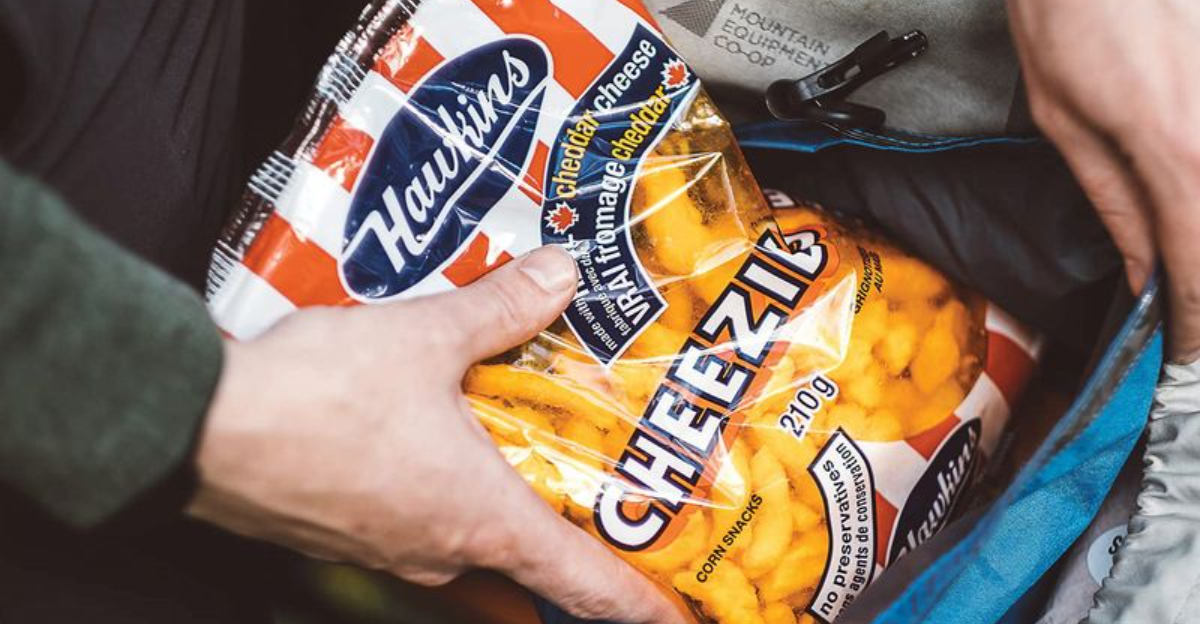15 Canadian Foods That Could Be Wiped Off U.S. Shelves Overnight

Have you ever stopped to think about where some of your favorite grocery items actually come from? You might be surprised to learn that many of the delicious products we enjoy every day are imported from Canada.
I recently learned this firsthand while talking to my uncle, who works in food distribution. He explained how countless Canadian-made snacks, sauces, and staples have quietly become part of everyday American life. However, this cross-border food flow isn’t guaranteed forever.
Trade disputes, supply chain disruptions, or changing regulations could easily impact availability—meaning some of our go-to grocery items could vanish from shelves overnight.
1. Maple Syrup: Liquid Gold at Risk
Breakfast at my grandmother’s house always meant pancakes drowning in real Canadian maple syrup. Nothing compares to its complex sweetness!
Canada produces over 70% of the world’s maple syrup, with Quebec being the epicenter of this sticky business. The Federation of Quebec Maple Syrup Producers even maintains a strategic reserve (yes, like oil but sweeter) to control global prices.
Trade disputes could easily disrupt this flow of amber goodness. Climate change threatens maple trees too, potentially reducing sap production. Without Canadian imports, Americans would face skyrocketing prices and possibly resort to—gasp—artificial syrups.
2. Ketchup Chips: The Crimson Snack Sensation
My first taste of ketchup chips came during a summer camp in Toronto. One bite of these tangy, tomato-dusted potato slices and I was hooked!
Strangely, these crimson-colored crisps remain primarily a Canadian obsession. Lays and Old Dutch versions have sneaked across the border into northern states, creating cult followings. The distinctive vinegary-sweet flavor profile has no American equivalent.
Supply chain disruptions or ingredient shortages could easily halt their limited U.S. distribution. Fans would need to organize Canadian snack runs or resort to DIY versions, sprinkling ketchup powder on plain chips—a poor substitute for the real deal.
3. Nanaimo Bars: Layered Dessert Delight
Last Christmas, my Canadian cousin introduced me to Nanaimo bars, and I nearly fainted from sugary bliss. These no-bake treats feature three heavenly layers: chocolate graham cracker crust, yellow custard buttercream, and chocolate ganache topping.
Named after the city of Nanaimo in British Columbia, these squares have gradually appeared in specialty bakeries and grocery freezer sections across America. Their distinctive yellow middle layer makes them instantly recognizable.
Any cocoa shortage or dairy supply issues could quickly eliminate these indulgences from American shops. The complex recipe requires specific ingredients that, if disrupted, would leave sweet-toothed fans bereft of this iconic Canadian confection.
4. Poutine Sauce: Gravy with a Twist
During a road trip through Montreal, I stumbled upon the magical elixir known as poutine sauce. This isn’t your ordinary gravy—it’s a velvety, savory potion that transforms plain fries and cheese curds into Canada’s national treasure.
St. Hubert and Swiss Chalet brands have brought this special sauce to American specialty stores. Its unique blend of chicken, beef, and secret spices creates a flavor impossible to replicate with American gravies.
Importing restrictions on prepared foods could easily cut off this supply. Poutine-loving Americans would be left attempting homemade versions that never quite capture the authentic Canadian magic that makes proper poutine so irresistibly comforting.
5. Coffee Crisp: The Chocolate Bar Americans Crave
The sound of my Canadian roommate unwrapping a Coffee Crisp would make my mouth water instantly. This unique chocolate bar combines light, crispy wafers with coffee-flavored filling and milk chocolate coating—a textural and flavor experience unlike anything in the American candy aisle.
Nestlé produces this iconic treat primarily for the Canadian market. However, border towns and specialty import shops have made it available to lucky Americans who discover its coffee-infused magic.
Any manufacturing changes or import regulations could swiftly remove this beloved bar from American reach. The distinctive yellow packaging with coffee-cup imagery would disappear, leaving chocolate enthusiasts bereft of its perfect balance of coffee flavor and chocolate goodness.
6. All-Dressed Chips: Flavor Explosion in a Bag
My Canadian brother-in-law introduced me to all-dressed chips at a family picnic, and I’ve never looked at plain potato chips the same way since. These crisps deliver an incredible flavor combination—tangy vinegar, smoky barbecue, zesty ketchup, and savory onion and garlic all in one magnificent chip!
Ruffles has brought limited editions to American stores, but the full Canadian version remains superior. The distinctive reddish seasoning creates an umami explosion that American snackers have increasingly sought out.
Any ingredient sourcing issues or marketing shifts could easily end their sporadic U.S. appearances. Chip enthusiasts would need to trek north or settle for single-flavor varieties, missing out on this uniquely Canadian snacking masterpiece.
7. Butter Tarts: Sweet Sticky Northern Treasures
Grandma Peterson (my honorary Canadian grandma) would make butter tarts that caused family arguments over who got the last one. These pastries feature flaky shells filled with a gooey mixture of butter, sugar, and eggs—sometimes with raisins or pecans for extra texture.
Small bakeries in border states have attempted to recreate these treats, but authentic versions from Canadian bakeries occasionally make it to specialty shops. The debate over raisins or no raisins is as Canadian as hockey!
Any disruption to bakery imports could cut off this sweet supply line. The uniquely Canadian dessert hasn’t quite caught on with American commercial bakers, making the imported versions particularly precious to those who know and love these sweet, sticky treasures.
8. Smarties: Not the American Kind
Confusion reigned when I asked for Smarties in Toronto and received chocolate buttons instead of the powdery candy I expected! Canadian Smarties are candy-coated chocolate buttons similar to M&Ms but with a distinct taste and cultural significance north of the border.
Nestlé produces these colorful treats primarily for Canadian consumers. The iconic cardboard tube packaging and slightly sweeter chocolate formula distinguish them from any American counterpart.
Manufacturing decisions or trademark issues could easily prevent their limited U.S. distribution. The color variety—including the unique Canadian debate over which color tastes best (it’s the red ones, obviously)—would disappear from American candy aisles, leaving chocolate lovers with fewer rainbow-colored options.
9. Jos Louis Cakes: Red Velvet Revolution
My hockey tournament trips to Quebec always ended with a celebratory Jos Louis cake from the convenience store. These circular red velvet cakes with creamy white filling and chocolate coating are basically the Canadian version of a Ding Dong, but with a distinctive maple-tinged flavor profile.
Made by Vachon, these individually wrapped treats occasionally appear in northern states and specialty Canadian goods stores. Their soft cake and sweet filling create a nostalgic experience for Canadians and converts alike.
Any manufacturing changes or distribution decisions could quickly remove them from American reach. Their relatively short shelf life makes them more vulnerable to supply chain disruptions than many other Canadian treats that make their way south.
10. President’s Choice Decadent Chocolate Chip Cookies
When my cousin from Toronto visits, she always smuggles in a box of President’s Choice “The Decadent” chocolate chip cookies. One bite explains why—these aren’t your ordinary store-bought cookies but rather chocolate-laden discs of perfection.
Loblaw’s President’s Choice brand has achieved legendary status with these cookies. Some specialty retailers in border states carry them, creating devoted American fans who stock up whenever possible.
Distribution changes or ingredient sourcing issues could easily end their limited American availability. The generous chocolate-to-cookie ratio and distinctive taste have no real American equivalent, making them particularly missed when supply lines are disrupted.
11. Hawkins Cheezies: The Cheese Puff Perfected
Last summer, I discovered Hawkins Cheezies at a lakeside cottage in Ontario and couldn’t believe what I’d been missing. Unlike American cheese puffs, these crunchy corn snacks are irregular in shape, extra crunchy, and coated with aged cheddar that delivers a sharp, authentic cheese flavor.
W.T. Hawkins has been making these distinctive snacks since 1949 using the same recipe and machinery. Their limited U.S. distribution makes them a treasured find for American snack enthusiasts.
The company’s small production capacity makes them particularly vulnerable to export disruptions. Any changes to food coloring regulations or dairy import restrictions could quickly cut off the supply of these uniquely textured, intensely flavored cheese snacks.
12. Canadian Bacon: Not Just for Breakfast
My first encounter with real Canadian bacon left me questioning everything I thought I knew about breakfast meats. Unlike the round ham Americans call “Canadian bacon,” authentic peameal bacon is wet-cured pork loin rolled in cornmeal, creating a tender interior with a slightly crunchy exterior when cooked.
This specialty meat makes occasional appearances in upscale American delis and specialty butcher shops. Its lean profile and distinctive flavor have earned it a following among health-conscious meat lovers.
Pork import regulations or processing requirement changes could quickly halt its availability. The cornmeal coating—originally peameal, hence the name—creates a unique texture that American producers haven’t successfully replicated, making the Canadian import irreplaceable.
13. Crispy Crunch: The Peanut Butter Brittle Bar
Finding a Crispy Crunch in my Halloween candy bag was always the jackpot! This uniquely textured candy bar combines peanut butter brittle covered in milk chocolate—creating a satisfying crunch that’s completely different from American peanut butter cups or Butterfingers.
Cadbury produces these distinctive yellow-packaged treats primarily for the Canadian market. They occasionally appear in specialty candy shops or border town stores, delighting Americans lucky enough to discover them.
Manufacturing priorities or ingredient sourcing changes could easily eliminate their limited U.S. presence. The brittle’s distinctive honeycomb-like texture and peanut butter flavor profile remain uniquely Canadian, giving candy enthusiasts yet another reason to plan a northern road trip.
14. Kraft Dinner: Not Your American Mac and Cheese
My Canadian college roommate would whip up “KD” during late-night study sessions, insisting the American version paled in comparison. Kraft Dinner—what Canadians call their boxed macaroni and cheese—has a different formula north of the border that fans swear tastes creamier and cheesier.
While similar to American Kraft Mac & Cheese, the Canadian version uses different cheese powder and formulation. Cross-border shoppers often stock up on the Canadian version, convinced of its superiority.
Recipe standardization or manufacturing consolidation could eliminate these regional differences. Canadians consume 55% more KD per capita than Americans, making it a cultural icon that occasionally makes its way to specialty grocers in the States.
15. Tim Hortons Coffee: Brew at Home Version
Nothing triggers my Canadian vacation memories like the distinct aroma of Tim Hortons coffee. While the donut chain has locations in some U.S. states, their packaged coffee for home brewing maintains a cult following among Americans who’ve experienced the real deal.
The distinctive medium roast blend appears in some American grocery stores, particularly in northern states. Its smooth, never bitter profile differs noticeably from American coffee chain offerings.
Distribution priorities or packaging changes could easily restrict its U.S. availability. The iconic red packaging represents more than just coffee to Canadians—it’s a national institution—making its occasional American appearances particularly special for those who recognize its cultural significance beyond just being a delicious cup of joe.
